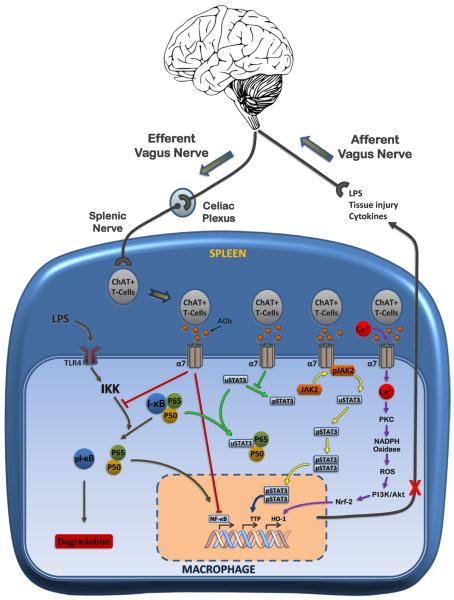nanonug
Senior Member
- Messages
- 1,709
- Location
- Virginia, USA
https://www.ncbi.nlm.nih.gov/pmc/articles/PMC4546521/
Abstract
Inflammatory responses to stimuli are essential body defenses against foreign threats. However, uncontrolled inflammation may result in serious health problems, which can be life-threatening. The α7 nicotinic acetylcholine receptor, a ligand-gated ion channel expressed in the nervous and immune systems, has an essential role in the control of inflammation. Activation of the macrophage α7 receptor by acetylcholine, nicotine, or other agonists, selectively inhibits production of pro-inflammatory cytokines while leaving anti-inflammatory cytokines undisturbed. The neural control of this regulation pathway was discovered recently and it was named the cholinergic anti-inflammatory pathway (CAP). When afferent vagus nerve terminals are activated by cytokines or other pro-inflammatory stimuli, the message travels through the afferent vagus nerve, resulting in action potentials traveling down efferent vagus nerve fibers in a process that eventually leads to macrophage α7 activation by acetylcholine and inhibition of pro-inflammatory cytokines production. The mechanism by which activation of α7 in macrophages regulates pro-inflammatory responses is subject of intense research, and important insights have thus been made. The results suggest that activation of the macrophage α7 controls inflammation by inhibiting NF-κB nuclear translocation, and activating the JAK2/STAT3 pathway among other suggested pathways. While the α7 is well characterized as a ligand-gated ion channel in neurons, whole-cell patch clamp experiments suggest that α7's ion channel activity, defined as the translocation of ions across the membrane in response to ligands, is absent in leukocytes, and therefore, ion channel activity is generally assumed not to be required for the operation of the CAP. In this perspective, we briefly review macrophage α7 activation as it relates to the control of inflammation, and broaden the current view by providing single-channel currents as evidence that the α7 expressed in macrophages retains its ion translocation activity despite the absence of whole-cell currents. Whether this ion-translocating activity is relevant for the proper operation of the CAP or other important physiological processes remains obscure.

Abstract
Inflammatory responses to stimuli are essential body defenses against foreign threats. However, uncontrolled inflammation may result in serious health problems, which can be life-threatening. The α7 nicotinic acetylcholine receptor, a ligand-gated ion channel expressed in the nervous and immune systems, has an essential role in the control of inflammation. Activation of the macrophage α7 receptor by acetylcholine, nicotine, or other agonists, selectively inhibits production of pro-inflammatory cytokines while leaving anti-inflammatory cytokines undisturbed. The neural control of this regulation pathway was discovered recently and it was named the cholinergic anti-inflammatory pathway (CAP). When afferent vagus nerve terminals are activated by cytokines or other pro-inflammatory stimuli, the message travels through the afferent vagus nerve, resulting in action potentials traveling down efferent vagus nerve fibers in a process that eventually leads to macrophage α7 activation by acetylcholine and inhibition of pro-inflammatory cytokines production. The mechanism by which activation of α7 in macrophages regulates pro-inflammatory responses is subject of intense research, and important insights have thus been made. The results suggest that activation of the macrophage α7 controls inflammation by inhibiting NF-κB nuclear translocation, and activating the JAK2/STAT3 pathway among other suggested pathways. While the α7 is well characterized as a ligand-gated ion channel in neurons, whole-cell patch clamp experiments suggest that α7's ion channel activity, defined as the translocation of ions across the membrane in response to ligands, is absent in leukocytes, and therefore, ion channel activity is generally assumed not to be required for the operation of the CAP. In this perspective, we briefly review macrophage α7 activation as it relates to the control of inflammation, and broaden the current view by providing single-channel currents as evidence that the α7 expressed in macrophages retains its ion translocation activity despite the absence of whole-cell currents. Whether this ion-translocating activity is relevant for the proper operation of the CAP or other important physiological processes remains obscure.

